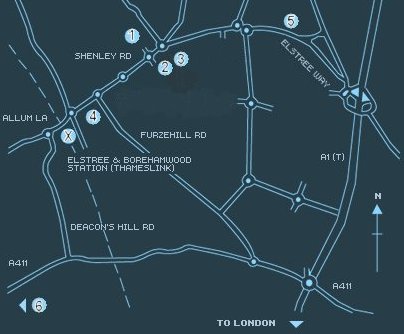First, let's clear up a couple of things........
Elstree is NOT a studio AND it's NOT in Elstree.
Still confused??? Let's take a closer look.... Elstree is actually Britains
only film township and not one studio but 6 different studios. Let's start
from the beginning......
In 1913, John East, Percy Nash and Arhur
Moss Lawrence got together for the purpose of starting a new film studio.
They wanted to build a modern studio outside of the fog of London, but close
enough for the ease of actors, supplies and distribution. They also wanted
enough land to make a wide variety of films. They located this beautiful
piece of land just outside of London at Elstree. Well..... they THOUGHT
it was Elstree. The railway was the dividing line between Elstree and Borehamwood
and the sign said Elstree Station. They happened to buy land on the Borehamwood
side.
Here's a map and breakdown of the studios
and their histories:

1. Neptune Studios
a. Neptune
Studios which ran from 1914-1917. It was liquidated in 1920, leased
by Ideal Films 1924-1928.
b. Ludwig
Blattner Film Corp. bought the studio in 1928 until the banks repossed
in 1932.
c. American producer, Joe Rock leased Neptune in 1935 until the banks
repossed in 1938.
d. Lady Yule bought the studio in 1941 and named it British
National Studio, closed it in 1948.
e. Douglas Fairbanks Jr. leased the studio in 1952 and named it National
Studios.
f. ATV bought the studio in 1962 for television production.
g. BBC Television bought the studio in 1984.
2. British National
Studios
a. original studio built in 1925, John
Maxwell took control in 1926 and renamed British
International Pictures (BIP)
b. Maxwell reorganized and changed the name to Associated-British
Pictures Corp. (ABPC) in 1933.
c. Take over of ABPC in 1969 by EMI and renamed EMI-Elstree.
d. Merger with MGM-British when they closed their studio across the street.
The name was changed to EMI-MGM in 1970.
e. MGM pulled out in 1973, changing the name back to EMI-Elstree.
f. EMI merged with Columbia-Warner in 1978, but while this was in the
process, Thorn Ind. bought the studios to become Thorn-EMI.
g. Cannon Organization purchased the studio in 1986 to name it Cannon
Studios.
h. Brent Walker Entertainment Group purchased the studio in 1988 and named
it Goldcrest Studios but shut down the studio in 1994.
i. Hertsmere Borough Council purchased the studio in 1996 and opened Elstree
Film & Television Studios
3. Imperial Studios
a. Herbert
Wilcox leased the buildings in that he helped build from John
Maxwell and named it Imperial Studios, in 1927 which was the home
of British
& Dominions Film Corp. the studio burned to the ground in 1936.
4. Whitehall Studio
a. Adelqui Millar built Whitehall
Studio in 1928 but closed it in 1929.
b. Consolidated Films leased the Studio in 1934 and changed the name to
Consolidated Studios.
c. Julius Hagen bought the studio in 1935 and closed it in 1937.
d. J. Banberger took control of the studio and changed the name to MP
Studios Ltd. in 1937 and produced several quota quickies.
e. Whitehall was requistioned during the war and used for war supplies.
d. Arthur Rank bought the studio for overflow production and changed the
name to Gate Studios and used it to make religious films.
e. In 1952, it was purchased by Andrew Smith Harkness to become the home
of Harkness Screens, the manufacturer of cinema screens until 2003. Aerofilms,
Britain’s leading supplier of aerial photography, also had an office
there.
f. The building was demolished in 2004 to make room for a housing project.
5. Amalgamated
Studio
a. Paul Soskin started building Amalgamated
in 1936. Contractors foreclosed in 1939.
b. J. Arthur Rank purchased while John
Maxwell negotiated for takeover.
c. Ministry of Works requisitioned the studio for war storage
d. Rank sold studio to Prudential in 1947
e. Prudential sold studio to
MGM and renamed MGM-British
in 1948 which operated it until 1970 when they closed the studio and merged
with EMI which was across the street.
f. Sold to a cold storage company who eventually tore down the studio
to make room for housing development
6. Danziger Studio
a. Danziger Brothers converted a engine testing factory
into 5 sound stage studio in 1956 that was located across the tracks and
actually IN Elstree. The studio was sold in 1965 and used for warehouse
storage.
Back to British Studios



